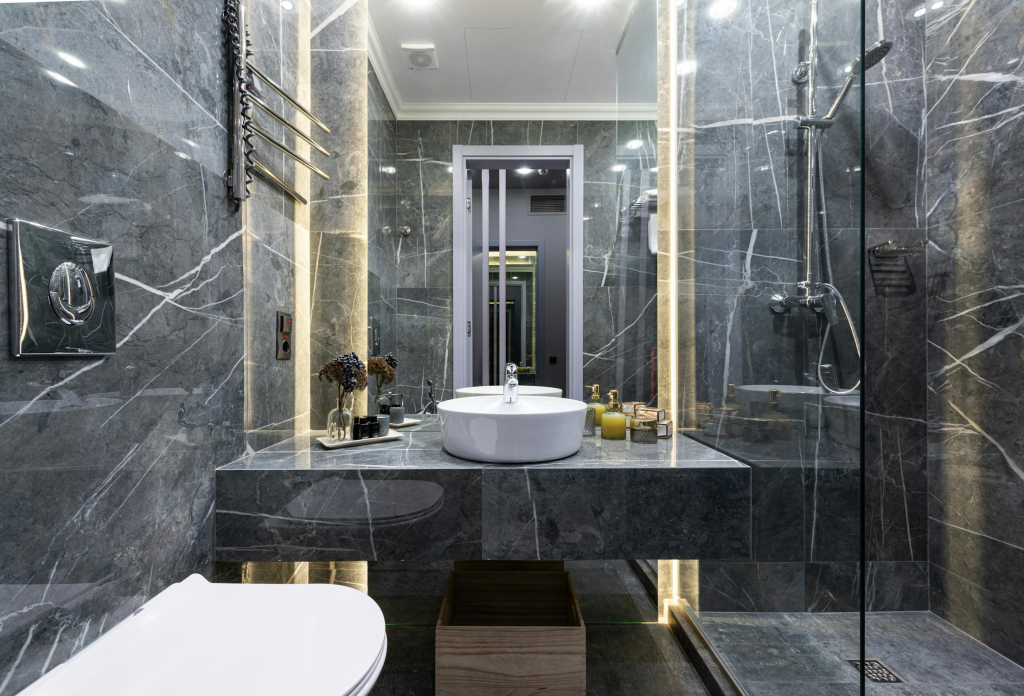Renovating a bathroom is a significant project that requires careful planning and a structured approach. Whether you’re updating an outdated space or creating your dream spa-like retreat, the process can be exciting but also daunting without a clear strategy.

Knowing the sequence of renovating a bathroom can help you avoid common pitfalls, save time, and stay within budget. This article will guide you through the step-by-step process of bathroom renovation, highlighting key phases, essential considerations, and expert tips to ensure a successful outcome.
What Is The Sequence Of Renovating A Bathroom?
Understanding the correct sequence of tasks in a bathroom renovation is crucial to ensure the project runs smoothly and efficiently. Here is a typical sequence of events:
Planning and Design
- Before any work begins, take time to plan and design your bathroom. Consider factors like layout, style, and materials. This is also the time to think about your budget, the professionals you may need (like a plumber or tiler), and any permits required. Deciding on the look and feel of your new bathroom, including the colour scheme, tiles, fittings, and fixtures, will help create a clear vision for the project.
Demolition and Removal
- Once the plan is in place, the first physical step in the renovation is demolition. This involves removing the old fixtures, tiles, and fittings. You may need to get the room entirely, depending on the extent of your renovation. Be sure to protect the rest of your house from dust and debris by sealing off the bathroom area. It’s also important to carefully remove items like plumbing and electrical systems to avoid damaging any essential infrastructure.
Plumbing and Electrical Work
- After demolition, the next step is addressing the plumbing and electrical systems. This stage is critical, as it ensures your bathroom functions properly. A licensed plumber will relocate or replace plumbing if needed, and an electrician will work on lighting, outlets, and any new electrical fixtures. This is also the point where underfloor heating or ventilation systems would be installed. Proper planning at this stage is essential to avoid future issues like leaks or electrical problems.
Wall Framing and Flooring Installation
- Once the plumbing and electrical systems are in place, it’s time to install wall frames if needed. This could involve moving or altering the structure to create space for new features, such as a recessed shower niche or a larger vanity. Following this, the flooring is laid. Tiles are the most common option for bathroom floors due to their water resistance, but other materials like vinyl or stone can also be used. Make sure the subfloor is prepared and levelled before laying tiles or other flooring materials.
Wall and Ceiling Installation
- With the floor down, the next phase is installing the walls and ceiling. Depending on your design, this may include plastering, painting, or adding tiles to the walls. The ceiling should be moisture-resistant to prevent mould and dampness over time. The walls, particularly in the shower or bath area, must be waterproofed before any tiling begins. Ensuring that everything is properly sealed at this stage will prevent future water damage.
Tiling and Waterproofing
- Tiling is one of the most critical steps in bathroom renovation. Begin with wall tiles and then move on to the floor. Choose durable, water-resistant tiles that complement the design of your bathroom. Make sure the tile layout is well-planned to avoid small, awkward cuts. Waterproofing the bathroom is essential, especially in wet areas like the shower. Professionals typically use a waterproof membrane to seal the floor and walls before tiling to prevent water from seeping into the structure of the house.
Installation of Fixtures and Fittings
- Once the tiling is complete and the waterproofing is set, you can start installing the bathroom fixtures. This includes the bathtub, shower, toilet, sink, and vanity. It’s essential to measure and ensure everything fits as intended. Fittings like taps, showerheads, towel rails, and light fixtures are also installed at this stage. Paying attention to detail here will help achieve a polished, high-end look.
Final Touches and Inspection
- After the major installations, the final touches bring the bathroom together. This involves caulking, sealing joints, and painting any remaining surfaces. Ensure that all fixtures are tested to confirm they are functioning correctly. Lastly, a thorough inspection of the entire bathroom will ensure that everything is up to standard and meets any building codes or regulations.
How To Avoid Common Bathroom Renovation Mistakes?
Renovating a bathroom involves several steps, and it’s easy to make mistakes along the way. Being aware of these common pitfalls can help you avoid costly errors and keep your project on track:
Skipping the Planning Phase
- One of the biggest mistakes homeowners make is jumping into the renovation without a detailed plan. Without a clear vision of the layout, design, and budget, the project can quickly become overwhelming and costly. Proper planning ensures that all elements work together harmoniously and that there are no surprises down the line.
Overlooking Ventilation
- Bathrooms are prone to humidity and moisture, which can lead to mould and mildew if not properly ventilated. Make sure you include an adequate ventilation system, such as an exhaust fan, in your renovation plans. This will not only protect the structure of your bathroom but also improve air quality and reduce condensation.
Choosing Style Over Function
- While aesthetics are important, functionality should be a priority in bathroom design. Don’t choose fixtures and fittings based solely on their appearance. Consider factors like water efficiency, durability, and ease of cleaning when selecting items like taps, showerheads, and toilets. A well-designed bathroom should be both beautiful and practical.
What Are The Costs Involved In Renovating A Bathroom?
The cost of a bathroom renovation can vary significantly depending on factors such as the size of the bathroom, the complexity of the project, and the materials chosen. Here’s a breakdown of the main cost factors:
Labour Costs
- Hiring professionals for plumbing, electrical work, and tiling can be one of the most significant expenses in a bathroom renovation. While you can tackle some DIY tasks, it’s essential to hire qualified tradespeople for specialized jobs to ensure safety and quality. Labour costs will depend on the size of the bathroom and the complexity of the work.
Materials and Fixtures
- The quality and type of materials you choose will have a significant impact on the overall cost. High-end tiles, countertops, and fixtures can quickly drive up the budget. If you’re looking to save money, consider using mid-range materials that still offer durability and style. It’s also worth shopping around for deals or sales on fixtures.
Unexpected Costs
- Always include a buffer in your budget for unexpected costs. During the demolition phase, for example, you might uncover hidden issues like water damage or structural problems that need to be addressed. Having a contingency fund can help you manage these surprises without blowing your budget.
Conclusion
Renovating a bathroom is a complex project that requires careful planning and execution. By following the correct sequence—starting with design and demolition, then moving on to plumbing, electrical, and installation work—you can ensure a smooth renovation process.
Avoid common mistakes by prioritizing functionality and ventilation, and be mindful of the costs involved, leaving room for unexpected expenses. With the right approach, your new bathroom will not only be beautiful but also functional and long-lasting.
Click and see this page for more information!
